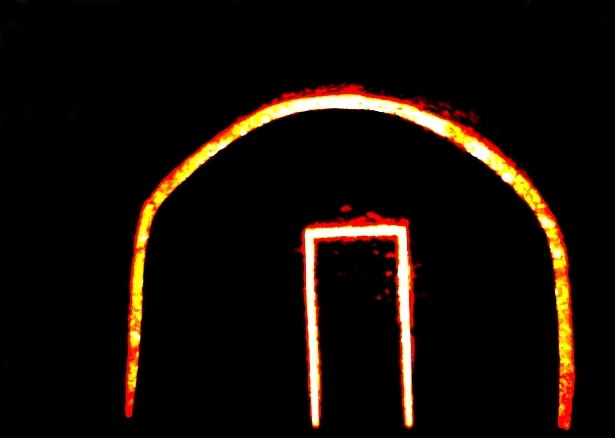An Inner Sound
What unmistakably defines Fabrizio Crisafulli’s activity in the context of contemporary research is his ability, almost a dowser’s instinct, to go beyond the purely formal value of artistic tools, to capture a hidden dimension, a special disposition of the soul, impenetrable to the relentless recognition of the eye, visible only through the sensitive antennae of an inner movement.
The originality of his work isn’t in the selection of tools or in spectacular multimedia solutions, but in how materials are investigated and reviewedusing a process that springs from a rare quality in a theatre professional, in other words the ability to be receptive or, even better, what I would call, a bent for listening. Crisafulli’s works never originate from a rigid plan, nor do they obey a narrative logic or immediately recognizable laws. They are actually the result of a slow process, which follows in the intangible wake of suggestions of the imagination, literary inspiration, and evocative ideas or memories. Even when he uses a literary work as a reference point, as has been the case on some occasions, the reference to the source survives only as an inspirational impulse, but does not affect the creation directly, which proceeds by inner dynamics in absolute linguistic autonomy.
With a background in architectural studies and a strong connection to visual arts contexts, Crisafulli is an ambassador of theatre poetics which stem from the encounter between different languages, and aim to create a ‘text’ from within theatre practice itself, where, on the basis of a different theme each time, the elements – light, space, actors and sound – give life to a new system of relationships, to an audio-visual score, nourished by visionary imagination. This is where the ‘bent for listening’ comes into play, which isn’t only about the director’s attitude towards the action, but also involves all forces in the scene interacting with each other, which take on various echoes, depending on the context and secret correspondence established during the course of the work.
In accordance with a now common practice, adopted recently in mainstream theatre, Crisafulli tends to spurn the traditional stage set up and works on reinventing space using installation tactics, once a prerogative of the visual arts. Equally unconventional is his use of materials, removed from their habitual functions and promoted to the role of protagonists on set in line with a non-hierarchical vision, where each element acquires the same level of dignity and importance. This is the case with light, no longer employed to illuminate, but used instead to define and structure space and images, and even affect thedramaturgical creation.
Similarly the actor, originally the linchpin of the performance, loses his/her role as interpreter, becoming a live presence, with an individuality of tangible depth, able to act in space and time with the voice and expressive tension of gestures and movements. Sound, never pre-existent or brought in from the outside, is also closely related to the situation and context and arises from the same functional process, through the contamination of musical elements with sounds, voices and sonorities produced by the moving objects or people during rehersal, restoring the flow of past experiences through intermittent traces of memory.
Also closely related to the theme of memory is the treatment of space. It’s an aspect already present in performances made for the stage. It became the core inspiration for an original line of research from 1996 onwards, which Crisafulli calls the ‘theatre of places’1. The starting point for a ‘theatre of places’ project is choosing a location which, once selected for its specific typology and characteristics, in addition to the theme and meaning associated to it, is no longer considered as a simple set or backdrop, but actually becomes the performance’s roots and script.
In some respects the process would seem to be related to the technique of sampling, widely used in the visual arts. However, while with visual experiences the choice, the ‘framing’, tends to confuse expectations and de-contextualize the object, in this case the opposite is true – the place regains its identity, presenting itself as a catalyst for a series of energies, striking evocations, memories stratified in time, which also radiate from the surrounding environment and enrich its symbolic capacity.
Every place tells its own story, but to hear its voice and draw reason from it for inspiration you need to be ready to ‘tune in’ and, morphological and environmental characteristics aside, capture the hidden side, inhabited by presences which have evolved over time – deeprooted memories, but also mythical and legendary figures in some cases, which come into a visionary short-circuit with aspects of today’s reality, drawn from everyday life.
What we’re actually dealing with is not a nostalgic recovery of then place, but the probing of its several realities to be inscribed on the pages of a fresh dramaturgical creation entrusted to the driving force of the images and suggestions of the sound score. Dance, performances, poetry and visual events transform the pre-existing surroundings and create an evocative journey that annuls the usual temporal distinctions, creating a suspended dimension that welds the events unfolding to the spirit of the place. Natural or archaeological sites, historic buildings or Italian style theatres, each environment, beyond its importance, can become a ‘place’ and a theatrical template, taking on symbolic significance in a dialectic between past and present, real facts and poetic transfiguration, in a seductive game of roles, characterised by the movements of memory and
the imagination.
(Silvana Sinisi, An Inner Sound. Foreword, in Nika Tomasevic (ed.), Place, Body, Light. The Theatre of Fabrizio Crisafulli, 1991-2011, Artdigiland, Dublin, 2013, pp. 15-17)
